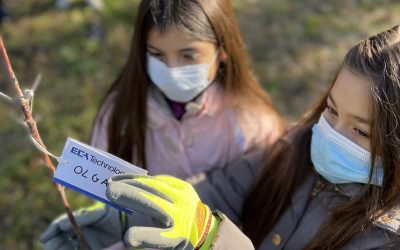
Through the #ECAgreen project carried out in collaboration with start-up Beleafing and the planting of trees in some of the most polluted areas in Italy, ECA Technology contributes to the achievement of 3 of the UN Sustainable Development Goals, such as:
UN Goal 11: Sustainable Cities and Communities “Make cities and urban settlements inclusive, safe, resilient and sustainable.”
The contribution of the ECA Technology project contributed 4.6 kg of particulate matter captured/year
UN Goal 13: Combat Change “Urgent measures should be taken to combat climate change and its impacts by regulating emissions and promoting developments in renewable energy.”
ECA Technology project contribution contributed 6.4 tons of CO2 absorbed/year
UN Goal 15: Life on Earth “Protect, restore and promote the sustainable use of the earth’s ecosystems, sustainably manage forests, combat desertification, halt land degradation and halt biodiversity loss.”
The contribution of the ECA Technology project contributed to the survival and reproduction of 3,000 more bees
This project is just the beginning of a lush journey we are taking together with all our ECA Technology partners and clients through whom we want to convey important values.
Planting trees in fact is one of the most important strategies for improving the quality of life in our cities, not only for environmental reasons but also for the benefit of public health and sustainable development.
What are the main benefits that tree planting brings? Let’s find out together:
- 1. Counteracting climate change: vegetation requires CO2 in order to carry out photosynthesis, so plants store large amounts of carbon during growth, functioning as “carbon sinks.” CO2 uptake varies with environmental conditions (temperature, light availability, etc.), species characteristics (leaf area, growth rates, etc.) and individual (age, health status, etc.). This ability to store atmospheric CO2 in the form of plant biomass or soil organic matter is critical in combating climate change.
- 2. Increased air quality by capturing fine particulate matter (PM10 – 2.5): Plants along roads or near highly polluted areas of the city contribute greatly to mitigating airborne dust concentrations by intercepting and trapping particles on their leaf surfaces. In addition, they can absorb gaseous pollutants such as ozone, nitrogen and sulfur oxides and are also an important resource for mitigating climate change and particularly extreme thermal events.
- 3. Hydrogeological risk reduction: tree planting is a concrete response to the issue of hydrogeological disruption. In fact, trees, thanks to their roots, have the power to consolidate the soil and increase its permeability, thus reducing the risk of floods, landslides and mudslides.
- 4. Decreased heat island effect: this phenomenon results in a warmer microclimate within urban city areas, with differences of up to 5 degrees. Trees are an effective solution to counter this phenomenon: they provide shade by intercepting and absorbing light, plus through evapotranspiration they actively cool the air in cities.
- 5. Improved quality of life: the presence of trees provides additional direct and indirect benefits to human health and well-being. Spending time among the trees improves physical and mental health by increasing energy levels, speeding recovery time, and decreasing blood pressure and stress.
- 6. Increased biodiversity: trees, especially at maturity, play a key role within terrestrial ecosystems; in fact, it is estimated that they provide food and habitat for more than 80 percent of the earth’s biodiversity. The integrity of ecosystems is a key element for life on earth to thrive.
Source: Beleafing x ECA Environmental Technology Report 2022